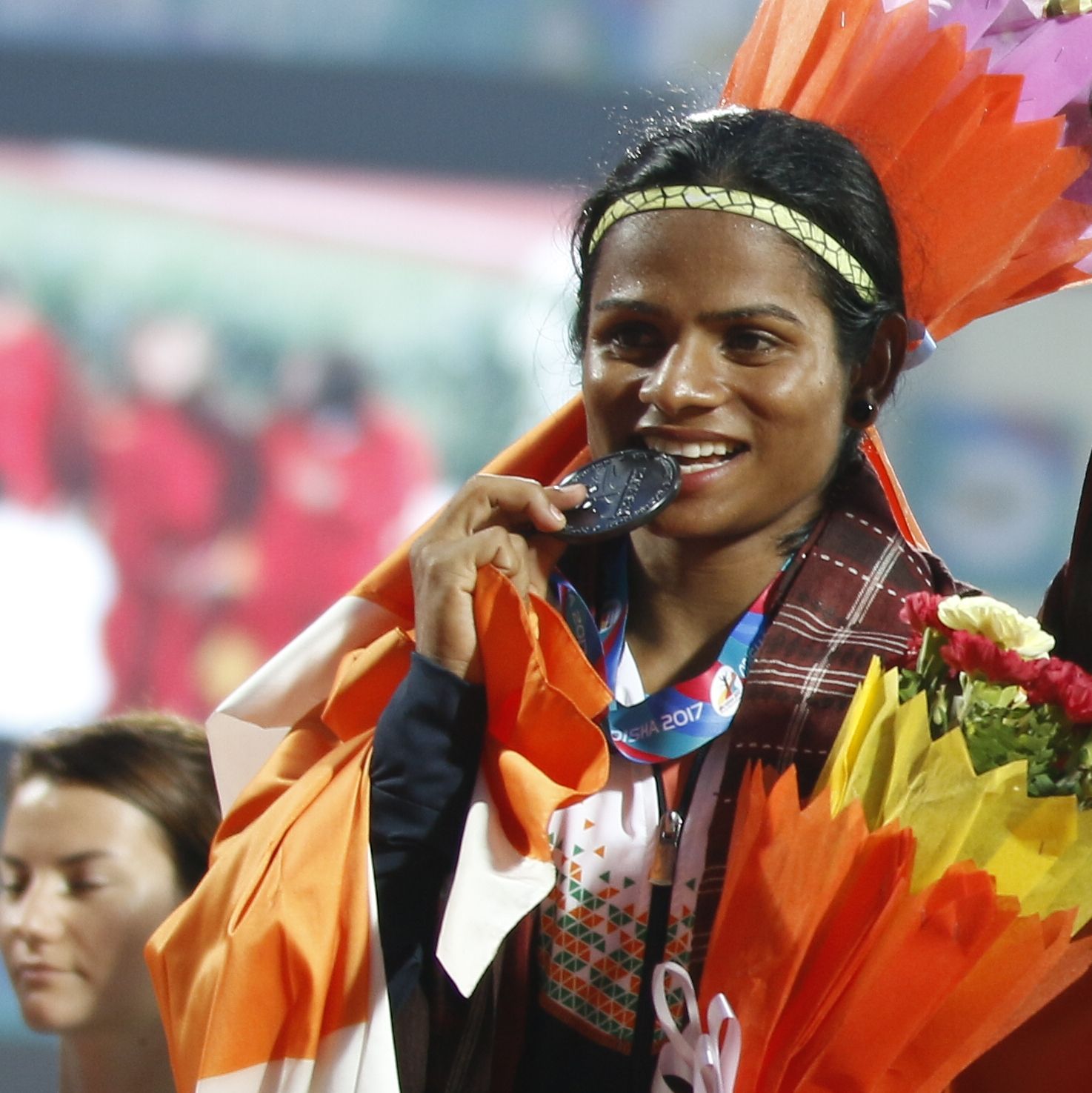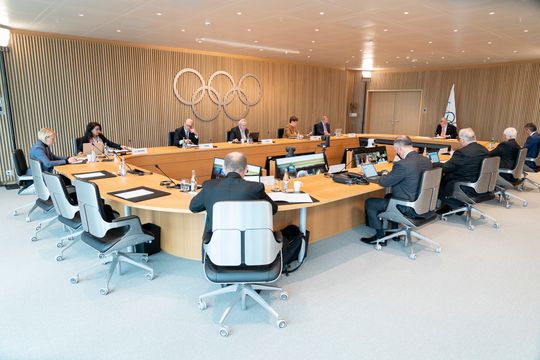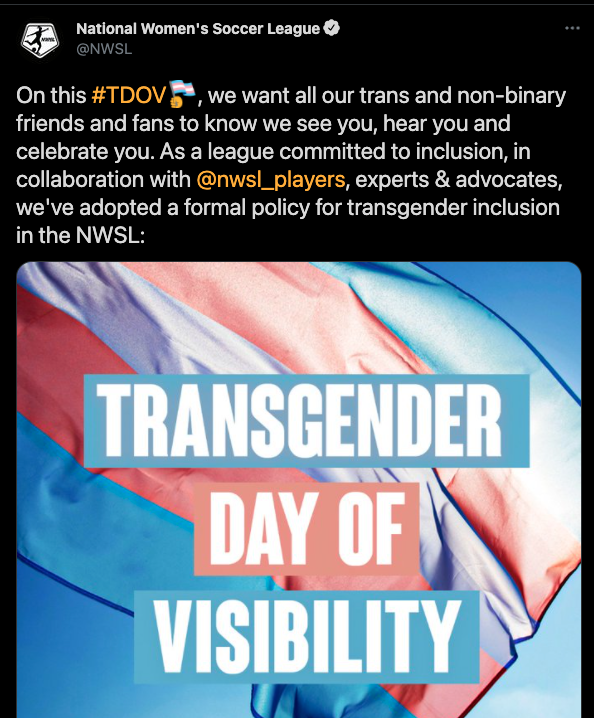This is the second of a three-part series that explores the history of gender testing in sports and how it affects the modern sporting climate. Part I looked at the early origins of gender testing; Part II looks at the years between 1999 and the present day and how gender testing has evolved.
Mandatory sex-verification testing of women athletes was a practice that had already faced much criticism by athletes, scientists, and human rights advocates as the 1990s drew to a close. As the 2000 Sydney Olympics neared, 29 of the 34 international sports federations had also abandoned mandatory gender testing of women's athletes. The IOC's decision to abandon mandatory gender testing in 1999 created a much different sporting landscape ahead of the Sydney Games in 2000.
When the IOC joined the IAAF and other international sports federations by ending mandatory gender testing of women's athletes in 1999, it could have been legitimate cause for celebration in the sporting world. Unfortunately, because these organizations reserved the right to selectively test individual women athletes whose gender caused "suspicion", the IOC was still regulating gender. Further, a disproportionate amount of the athletes affected by this selective testing and regulations were trans competitors and athletes with intersex traits. Most sports writers who chronicle the history of women's gender testing in elite sports and its related controversies jump straight from the abandonment of mandatory testing in 1999 to the controversy surrounding South African track star Caster Semenya in 2009. However, the IOC's approval of a transgender inclusion policy in 2004 is a seminal moment in gender regulation in elite sport that is often glossed over or not mentioned at all.
The Stockholm Consensus, the IOC's first transgender policy, was created in 2003 and ratified in 2004. It was ostensibly designed to create space for trans individuals to participate in sport at an elite level. In reality, the regulations made it even more difficult for trans athletes, especially trans women, to participate in sports. It forced trans individuals to undertake specific treatments before participating; treatments that, while important and integral for some trans individuals, should not required for athletic participation.
The doctrine was created by a group of seven medical doctors from three countries (Sweden, France, and the United States). The group was admittedly an "ad-hoc committee" and not the result of a thorough investigation into the realities facing trans athletes around the world. Only some of the committee members had relevant medical expertise (endocrinology, genetics) and none were experts in trans-specific medical care.
This policy is still widely accepted as a best-practice blueprint for trans inclusion policies in the sports world. However, this IOC committee neither understood the many aspects of transition nor the multiplicity of trans lives. The committee did not understand or research the experiences of elite trans athletes, or even of trans athletes at any level. Ultimately, the committee's own biases worked against the creation of truly inclusive regulation, or as sociologist Sheila L. Cavanagh and physical education professor Heather J. Sykes note in their article "Transsexual Bodies at the Olympics": "Strong indications were also give that the board was transphobic and so the committee defaulted into a defensive insistence upon the advantage thesis."
As a result, the transgender regulations created by this group undermined its alleged purpose, which was increased trans participation in elite sport. The Stockholm Consensus confirmed the IAAF recommendation from 1990 that "individuals undergoing sex reassignment of male to female before puberty should be regarded as girls and women (female). This applies as well for female to male reassignment, who should be regarded as boys and men (male)." Given that that committee's understanding of "sex reassignment" was both hormonal (in this case, puberty blockers) and surgical (procedures that aren't and never have been conducted on trans children), this clause highlights the committee's failure to understand best practices for trans children and is illustrative of their ignorance.
The committee's regulations for trans athletes who transitioned after puberty were especially punitive. The regulation stated:
The group recommends that individuals undergoing sex reassignment from male to female after puberty (and the converse) be eligible for participation in female or male competitions, respectively, under the following conditions:
- Surgical anatomical changes have been completed, included external genitalia changes and gonadectomy
- Legal recognition of their assigned sex has been conferred by the appropriate official authorities
- Hormonal therapy appropriate for the assigned sex has been administered >in a verifiable manner and for a sufficient length of time to minimise gender-related advantage in sport competitions.
In the opinion of the group, eligibility should begin no sooner than two years after gonadectomy.
Rather than creating opportunities for trans athletes to continue to compete in elite sports, the Stockholm Consensus aggressively limited the likelihood of trans competitors at the Olympics and other elite sporting events. The IOC's requirement of "legal recognition" of gender was an impossible condition to achieve for trans folks living in many countries. Despite considerable advances in trans rights since 2003, securing legal recognition of gender is still unattainable for many trans people. In 2016, 12 years after this qualification was implemented, it was still impossible for an individual to change their gender in two-thirds of countries worldwide. Furthermore, as of 2016, only five countries in the world allow trans folks to change their gender legally without restrictions. The vast majority of countries that allow individuals to legally change their gender require trans folks to meet specific medical (hormone therapy, surgery, sterilization, psychiatric diagnosis) or social requirements (childless, unmarried, age requirement). In many countries it is simply impossible for trans athletes to legally change their gender. For those living in countries where legal gender changes are possible, the required medical procedures are costly and are often not covered by government or corporate health plans, which can push legal gender change financially out of reach. Even when a trans person is able to meet the criteria to change their gender, the process can take months -- and in some cases, years. As difficult as it remains to change your gender now, it would have been exponentially harder at the time of the Stockholm Consensus.
Problematically, the Stockholm Consensus is part of a tendency to medicalize gender identity because it required trans athletes undergo both top and bottom surgeries, including reproductive system surgeries (forced castration or sterilization) to accept a trans athlete's gender identity. Transition takes a multitude of forms and such restrictive mandates prevent trans individuals from making changes (social, legal, hormonal, surgical) that work for them and meet their needs. Not only do such mandates violate the human rights of trans athletes, they undermine self-identification as a valid method of declaring trans identity.
The Stockholm Consensus perpetuated some of the most controversial aspects of the IOC's sex verification policy while mandating potentially unnecessary transition related procedures. Criticism of the "naked parades" of the 1960s highlighted the reality that genitalia did not confer athletic advantage, and yet more than three decades later, the IOC mandated "external genitalia changes" for trans athletes wishing to take part in elite sport. As genitalia still do not confer athletic advantage, this requirement is about forcing trans and intersex bodies to align with that of their cisgender and non-intersex competitors as closely possible. This is particularly true in terms of trans women, as such regulations are designed to strictly enforce "acceptable" and binary definitions of women's bodies.
Culturally, the Stockholm Consensus was another method of enforcing strict gender binaries and confirming non-cis men's bodies as lesser. As Cavanagh and Sykes state:
The Stockholm Consensus regulates access to binary gender identifications (male or female) when the IOC cannot agree – without equivocation and dispute – on what it is precisely that is being regulated. If male and female bodies are not natural (but social, culturally specific and thus mutable) the IOC is faced with the problematic of having to police (through medical and visual technologies) a categorical gender binary that cannot be shown to exist… we argue that the IOC policy –- with its fluency in post-operative transsexuality –- is a new disciplinary technique designed to manage gender designations.
It was important for the Stockholm Consensus to maintain a strict gender binary because international sports federations are invested in presenting women's sports as lesser, and therefore requiring "protection." Instead of focusing on broad transgender inclusion, the Stockholm Consensus prioritized the protection of "fair play" for cis women athletes. The regulations emphasized the importance of minimizing "gender-related advantage," which perpetuated the belief that afab and women's bodies are inherently lesser. Dr. Patrick Schamasch, then the Director of the IOC Medical Commission and one of the seven doctors who wrote the Stockholm Consensus, indicated as much when he stated the 2004 trans regulations were created "more to protect the athlete who has not been sex reassigned than to help the person who is."
Dr. Schamasch's attitude is widely-held in the cis sports world, even today. Transgender inclusion in sports has always been and continues to be selectively allowed and subject to discriminations by cis people. Transgender athletes must submit to cis standards and qualifications, while trans-accepted methods of identification, such as self-identification, continue to be dismissed. As Cavanagh and Sykes note, this policy is "symptomatic of a refusal to recognize self-identification with respect to gender. Priority is given to sex-testing regimes and narrow, medically governed, definitions of sexed bodies."
The Stockholm Consensus fundamentally misunderstood gender-diverse people, as its regulations refused to acknowledge trans individuals outside the traditional gender binary, as well as non-binary people more broadly. To be truly inclusive of gender-diverse athletes, such policies must recognize and include non-binary athletes. The Stockholm Consensus also failed athletes, particularly women's sports participants, with intersex traits. The 2004 policy makes no mention of athletes with intersex traits, despite the lengthy and well-documented history of these athletes being maligned and persecuted by the IOC and other international sporting federations.
The multiple failures of the Stockholm Consensus have plagued sports for more than a decade now, and trans athletes and athletes with intersex traits continue to fight for inclusion, acceptance, and the freedom to play. While many women athletes are now free to compete at the highest levels free from sex verification and gender testing, the reality is that, this burden has been unfairly shifted to trans, nonbinary, gender non-conforming athletes, and athletes with intersex traits. This burden routinely falls on athletes who do not meet western standards of white, feminine beauty. No one should be subject to such policing, but the most vulnerable athletes need to be defended against such discrimination as well.
In 2009, an 18-year-old Caster Semenya won gold in the 800 metres at the World Championships in Berlin. Semenya's dramatic improvements during the 2009 turned heads, but the increased speculation about her gender was rooted in the fact that she is tall, muscular, and Black. Pierre Weisse, general secretary of the IAAF at the time, stated "She is a woman, but maybe not 100 per cent." The IAAF opted to require a sex verification test for Semenya. The IAAF's handling of her case was appalling; news that the organization had required the test for Semenya broke hours before the 800 meter final. The IAAF clarified that the tests were required not because of doping concerns but because the sporting body wanted to determine whether she had an "unfair advantage." Semenya's results were not publicly revealed, though were widely leaked in the press. After an eleven-month break from competition, she was cleared to compete again in July 2010.
Semenya's case brought hyperandrogenism (or androgen excess), into the sports vernacular. Hyperandrogenism can occur in afab folks and is characterized by higher than typical levels of androgens (like testosterone). What's important about hyperandrogenism in terms of sport is the testosterone levels of women and afab athletes. Testosterone is found in both men and women, but is responsible for the development of primary sex characteristics in cis men, as well as secondary characteristics, such as increases in bone mass, muscle, and recuperative ability. Testosterone also carries significant cultural weight; many credit the typically higher testosterone levels of cis men as the reason for a man's virility, athletic ability, aggression, confidence, and other characteristics that are figured as essentially masculine.
However, it's important to realize that the "normal" testosterone levels for both men and women are arbitrary and constructed. They are arbitrary because different organizations use different average ranges. For instance, the IAAF (who are intent on restricting women athletes based on testosterone levels) considers the "normal female range" to be 0.1-2.8 nmol/L whereas the medical department at Boston University considers the "normal female range" to be 1.0-3.5 nmol/L (though 2.7 nmol/L is the upper limit typically used in sports). They are constructed because we have numerous examples of women and afab folks with high T levels (10 nmol/L and more), and rather than expanding the range of possible T levels for women, we create a cutoff and categorize those natural levels as within the "normal male range" (which is between 10 nmol/L to 35 nmol/L). Many men and women fall within these normal ranges, but not all do. Some women have T levels higher than what is typically accepted for women, but lower than what is typically accepted for men. The "normal male range" varies considerably, yet this is never problematized. That we consider women with higher T levels "abnormal" is problematic because we stigmatize women with higher T levels, we question their gender, restrict their access to sport, require hormonal and other medical treatments, and undermine their identities, all to maintain a strict gender binary that is increasingly harder to justify.
Semenya competed in the 2012 Games in London, winning silver in the 800 metres, her signature race (a result that would be upgraded to gold when Russian runner Mariya Savinova was stripped of her Olympic medals and banned for life due to doping infractions). But Semenya's success was the driving force behind the IAAF and the IOC creating Regulations on Female Hyperandogenism, introduced in 2011 and expanded upon in 2012 respectively. Both policies specified that women with testosterone levels in the "typical male range" (though neither organization set a specific limit for testosterone) were ineligible to compete in women's categories unless they had an androgen resistance or sought medical treatment to reduce their testosterone levels. However, these guidelines contradict standards of ethical care. When hyperandrogenism is the result of an endocrine condition, "authoritative guidelines such as those of the American Association of Clinical Endocrinologists do not set specific testosterone levels that indicate disease and warrant intervention". This is because the effects and treatments of endocrine conditions vary widely depending on each patient. The purpose of these regulations was clear: to maintain the gender binary in elite sports. As the IAAF Regulations state: "Competition in athletics will continue to be divided into men's and women's competition recognising that there is a difference in sporting performance between elite men and women, that is predominantly due to higher levels of androgenic hormones in men."
The Regulations on Female Hyperandrogenism were immediately damaging. When suspected of having hyperandrogenism, women athletes were subjected to further testing, which included full physical and gynecological examinations, endocrine testing, and psychological assessment. With their careers in jeopardy, such testing is as abusive as the physical and manual examinations of the 1960s. According to Dr. Katrina Karkazis, a medical anthropologist and bioethicist, regulating testosterone levels is merely the latest sex-testing development: "Despite the scientific-sounding rationale about competitive advantage, only the screening criterion has changed; it's now testosterone levels. Unlike chromosomes, T levels can be manipulated, and so for the first time women are required—effectively coerced—to change their bodies to maintain eligibility."
In 2013, doctors in Nice reported that they operated on four women with hyperandrogenism who were between the ages of 18 and 21 and were from "rural or mountainous regions of developing countries". Their continued athletic participation under threat, these women had gonadectomies and partial clitoridectomies that were deemed medically unnecessary by those same doctors. As sociomedical scientist Dr. Rebecca Jordan-Young, endocrinologist Dr. Peter Sonksen, and Dr. Karkazis note in their article "Sex, Health, and Athletes" regulating hyperandrogenism results in women without health concerns having "medically unnecessary interventions with long-term consequences in order to continue their careers."
The primary concern of international sports federations is the regulation of testosterone, not the health of the athlete. Gonadectomies have considerable repercussions, which affect physical and mental health, reproductive health, and incur considerable lifelong financial cost. As a result, "The testosterone based eligibility policies turn standard medical decisions making about hyperandrogenism on its head."
The fairness of regulating against hyperandrogenism in elite sport was challenged when Indian sprinter Dutee Chand was dropped from her nation's Commonwealth Games team in 2014 after testing revealed that she had hyperandrogenism. When Chand's case became public, both the Athletic Federation of India and the IAAF policy were criticized. Chand courageously fought the ruling and her government appealed the IAAF decision to the Court of Arbitration for Sport (CAS) in a case known as Chand v AFI and IAAF. In 2015 CAS suspended the hyperndrogenism regulation for women athletes participating in IAAF events, because insufficient scientific evidence existed to connect higher testosterone levels in women with athletic advantages. The ruling was not abolished, but gave the IAAF two years, until 2017, to provide the CAS with additional proof that higher testosterone levels in women athletes constitutes an unfair advantage.
The Chand case also forced the IOC to act and revisit both its policies on hyperandrogenism and transgender athletes in November 2015. In these updated regulations, the IOC stated its desire for CAS to reinstate hyperandrogenism regulations: "The IAAF, with support from other International Federations, National Olympic Committees and other sports organisations, is encouraged to revert to CAS with arguments and evidence to support the reinstatement of its hyperandrogenism". However, it complied with the CAS ruling on the Chand case, allowing athletes like Semenya and Chand to participate in the 2016 Olympics in Rio. In July 2017, the IOC announced that athletes with hyperandrogenism will be allowed to compete at the next winter Olympics in PyeongChang in 2018, because a final ruling has not yet occurred in the Chand ruling.
In January 2016, the IOC adopted the transgender regulations the committee on Sex Reassignment and Hyperandrogenism drafted in November 2015. There were important improvements to the Stockholm Consensus, must notably the removal of mandatory gender-confirmation surgery for all trans athletes. The IOC realized that "to require surgical anatomical changes as a pre-condition to participation is not necessary to preserve fair competition and may be inconsistent with developing legislations and notions of human rights." Trans women athletes are now free to participate in men's sports without restrictions, and trans men can continue to compete, regardless of the medical choices they make for their transition. While trans men being allowed to freely compete in men's sports is a positive change, it mostly reveals that the IOC and other sporting bodies don't see trans men as men. It also illustrates that the IOC still considers afab bodies as lesser and therefore inconsequential in terms of men's sports.
Unfortunately, trans women must still meet specific conditions to compete in women's sports. Trans women must declare their gender (that they are women) and can't change this declaration for four years. Trans men aren't required to make a similar declaration, and the only reason for requiring this additional step for trans women is the IOC endorsing the transphobic belief that trans women are somehow fraudulent. An organization that believes trans women are women wouldn't require such a regulation. This regulation is the latest example of the decades-long myth that cis men are disguising themselves to compete in women's sports. This simply does not happen, in part because of the frequent toxic masculinity in men's sporting culture. In addition to declaring their gender, trans women are still required to undergo hormone therapy and maintain testosterone levels below "normal male levels" of less than 10 nmol/L (the same restriction which had been placed on women athletes with hyperandrogenism). In addition, trans women must maintain this lower level of testosterone for at least a year (the IOC reserves the right to extend the waiting period on an individual basis). This "acceptable" level must be maintained "throughout the period of desired eligibility to compete in the female category." Failure to a maintain a T level below 10 nmol/L will result in a year's suspension from competition for trans women.
The IOC's decision to group its transgender policy and hyperadrogenism regulations together clarifies the purpose of these rules: to maintain strict definitions of gender and to ensure that women's bodies confirm to these definitions. Women who don't meet these regulations are allowed to participate in men's sports: "To avoid discrimination, if not eligible for female competition, the athlete should be eligible to compete in male competition". The Sex Reassignment and Hyperandrogenism policy actively discriminates, particularly against trans women and women/afab people with intersex conditions. It treats sex and gender as a rigid binary and once again ignores and erases nonbinary and many intersex athletes.
In July 2017, "Serum Androgen Levels and Their Relation to Performance in Track and Field: Mass Spectrometry Results From 2127 Observations in Male and Female Elite Athletes" by Drs. Stépane Bermon and Pierre-Yves Garnier was submitted for study and has since been published in the British Journal of Sports Medicine. The IAAF intends to use this study (and other evidence) as proof that women with hyperandrogenism have an unfair advantage, and as a result, CAS must reinstate the IAAF's hyperandrogenism policy.
The problem with this study, and more broadly the IAAF's and IOC's approach to these issues, is they still view women athletes with hyperandrogenism as "cheaters." The study was funded in part by the World Anti-Doping Agency and the introduction frames the article's arguments through the lens of androgen abuse (doping) on the part of women athletes. Deliberate and deceitful doping abuses are not equivalent to women with hyperandrogenism competing in elite women's sports.
The IAAF asserts that the difference in performance between men and women elite athletes "is predominantly due to higher levels of androgenic hormones in men" and the conventionally accepted gap between men's and women's performances are 10-12% . In "Serum Androgen Levels", Drs. Bermon and Garnier conclude that women athletes with high fT (free testosterone) levels "have a significant competitive advantage over those with low fT in 400 m, 400 m hurdles, 800 m, hammer throw, and pole vault." The margin of advantage in each of these 5 events (out of the 21 women's events at the IAAF) were "2.74%, 2.78%, 1.78%, 4.53%, and 2.94%, respectively." While those numbers are certainly notable, especially in hammer throw, they do not account for the bulk of the performance gap that is typically accepted by sporting bodies as the reason men's and women's sports should be separated. It should be noted that in 16 of 21 women's track and field events, women with hyperandrogenism were not shown to have any kind of advantage.
If fair play truly is the goal behind misguided attempts to regulate the gender of women, sports where greater strength and muscle mass are integral to success can be organized by weight class or category, like wrestling or weightlifting. These findings came from a narrow category of athletic competition (track and field events contested by individuals) where women with hyperandrogenism were shown to have a minor advantage. This minor advantage was present in less than 25% of all women's track and field sports. The study did not adequately address the gender performance gap between men and women, and it would be foolhardy to ignore other factors, such as cultural and financial factors, to explain that discrepancy. Ultimately, it would be incredibly damaging to women's sports to so broadly apply findings from 5 events reported in one study.
CAS will eventually make a final decision on the Dutee Chand case. When that happens, it's possible that CAS will void the IAAF hyperandrogenism regulations. It's also possible that CAS agrees with the IAAF, the IOC, and the other sporting federations that wish to place strict penalties on athletes with hyperandrogenism. But if the history of gender policing in sports teaches us anything, it's that women, trans folks, and athletes with intersex traits are subjected to regular violations and evolving humiliations all in the name of "fair play."
(Photo credit: Wikimedia Commons)







